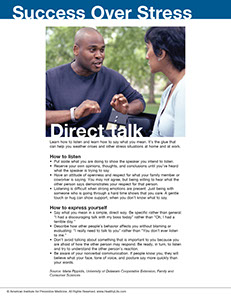SYMPTOM CHECKER
CONDITIONS
Male
Female
Child
Arm, Hand & Shoulder Concerns
Legs & Feet Concerns
Dental & Mouth Concerns
Ear & Nose
Eye Conditions
Head Conditions
Arm, Hand & Shoulder Concerns
Legs & Feet Concerns
Front
Back
Arm, Hand & Shoulder Concerns
Dental & Mouth Concerns
Ear & Nose
Eye Conditions
Head Conditions
Arm, Hand & Shoulder Concerns
Dental & Mouth Concerns
Ear & Nose
Eye Conditions
Head Conditions
Front
Back
Arm, Hand & Shoulder Concerns
Neck Links
Head & Neck Concerns
Arm, Hand & Shoulder Concerns
Neck Links
Head & Neck Concerns
Front
Back
Online Clinic
Wise Healthcare
Direct talk

Print on Demand
Learn how to listen and learn how to say what you mean. It’s the glue that can help you weather crises and other stress situations at home and at work.
How to listen
• Put aside what you are doing to show the speaker you intend to listen.
• Reserve your own opinions, thoughts, and conclusions until you’ve heard what the speaker is trying to say.
• Have an attitude of openness and respect for what your family member or coworker is saying. You may not agree, but being willing to hear what the other person says demonstrates your respect for that person.
• Listening is difficult when strong emotions are present. Just being with someone who is going through a hard time shows that you care. A gentle touch or hug can show support, when you don’t know what to say.
How to express yourself
• Say what you mean in a simple, direct way. Be specific rather than general: “I had a discouraging talk with my boss today” rather than “Oh, I had a terrible day.”
• Describe how other people’s behavior affects you without blaming or evaluating: “I really need to talk to you” rather than “You don’t ever listen to me.”
• Don’t avoid talking about something that is important to you because you are afraid of how the other person may respond. Be ready, in turn, to listen and try to understand the other person’s reaction.
• Be aware of your nonverbal communication. If people know you, they will believe what your face, tone of voice, and posture say more quickly than your words.
Source: Maria Pippidis, University of Delaware Cooperative Extension, Family and Consumer Sciences
This website is not meant to substitute for expert medical advice or treatment. Follow your doctor’s or health care provider’s advice if it differs from what is given in this guide.
The American Institute for Preventive Medicine (AIPM) is not responsible for the availability or content of external sites, nor does AIPM endorse them. Also, it is the responsibility of the user to examine the copyright and licensing restrictions of external pages and to secure all necessary permission.
The content on this website is proprietary. You may not modify, copy, reproduce, republish, upload, post, transmit, or distribute, in any manner, the material on the website without the written permission of AIPM.
2021 © American Institute for Preventive Medicine - All Rights Reserved. Disclaimer | www.HealthyLife.com















































